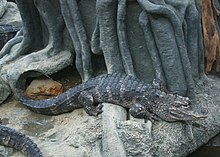Chinese alligator
| Chinese alligator Temporal range: -Holocene,0.7–0 Ma |
|
|---|---|
 |
|
| Scientific classification | |
| Kingdom: | Animalia |
| Phylum: | Chordata |
| Class: | Reptilia |
| Order: | Crocodilia |
| Family: | Alligatoridae |
| Genus: | Alligator |
| Species: | A. sinensis |
| Binomial name | |
|
Alligator sinensis , 1879 |
|
 |
|
| Synonyms | |
|
|
The Chinese alligator (Alligator sinensis) (simplified Chinese: 扬子鳄; traditional Chinese: 揚子鱷, yáng zǐ è), also known as the Yangtze alligator, is one of two known living species of Alligator, a genus in the family Alligatoridae. This critically endangered species is endemic to eastern China.
While its appearance is very similar to the only other living member of the genus, the American alligator (Alligator mississippiensis), a few differences exist. Usually, this species attains an adult length of only 5 feet (1.5 m) and a mass of 80 pounds (36 kg). Exceptionally large males have reached 7 feet (2.1 m) in length and 100 pounds (45 kg) in weight. Reports are known of alligators in China reaching 10 feet (3.0 m) in centuries past, but these are now generally considered apocryphal. Unlike the American alligator, the Chinese alligator is fully armored; even its belly—a feature of only a few crocodilians.
Overall, the Chinese alligator lives in a subtropical, temperate region. The Chinese alligator's usual habitat was in places of low-elevation and freshwater sources. This includes marshes, lakes, streams, and ponds. Wetlands are extremely important to the Chinese alligators due to the biodiversity that is within them.
The alligator originally ranged through much of China. However, in the 1950s, the Chinese alligator was found only in the southern area of the Yangtze River (Chang Jiang) from Pengze to the western shore of Lake Tai (Tai Hu), in the mountainous regions of southern Anhui, and in Jiangsu and Zhejiang provinces. They were usually found in the lakes, streams, and marshes for a time. But in the 1970s, the species was restricted to a small part of southern Anhui and the Zhejiang provinces. Then, in 1998 the biggest area the alligator lived in was a small pond along the Yangtze River surrounded by farmland, and only 11 alligators lived inside of it. At this point, the alligator's geographic range had been reduced by 90%. The Chinese alligator's population reduction has been mostly due to conversion of its habitat to agricultural use. A majority of their usual wetland habitats has been turned into rice paddies.Poisoning of rats, which the alligators then eat, has also been blamed for their decline. It was also not uncommon for people to kill the alligators, because they believed they were pests, out of fear, or for their meat. In the past decade, very few wild nests have been found, and even fewer produced viable offspring.
...
Wikipedia

